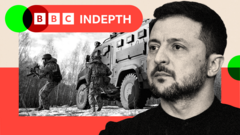The ongoing conflict in Ukraine shows no signs of abating even as Russia makes incremental territorial gains in the eastern regions of Donbas. President Vladimir Putin noted the shifting dynamics during his recent year-end address, highlighting the military's consistent advance across the front lines. Civilians face difficult choices, some evacuating ahead of hostilities while others remain until the threat nears their homes.
As the situation grows increasingly dire for Ukraine, which is grappling with a substantial humanitarian toll estimated at over a million casualties, looming political changes in Washington could alter the war's trajectory. With Donald Trump poised to assume the presidency, there is speculation on how his leadership might influence U.S. foreign policy regarding Ukraine, especially considering his previous dismissive comments about the conflict.
Trump, known for his unpredictability, has claimed he could resolve the war within 24 hours of taking office, although there are doubts about the feasibility of such promises. As observers note, he criticizes U.S. involvement while reflecting concerns over the staggering losses among Ukrainian soldiers, emphasizing the need for a more pragmatic approach.
Yet, Trump's perspective is muddled. During interviews, he has cast skepticism on extensive military assistance to Ukraine, sparking fears among Ukrainian officials about potential reduced support. Mykhailo Podolyak, an advisor to President Zelensky, dismissed imminent negotiations as unrealistic, reiterating that substantive talks cannot occur without Russia facing stronger repercussions for its aggression.
In a strategic move, Zelensky has attempted to engage positively with Trump's administration by positioning himself as a constructive counterpart. His outreach for cooperation has included congratulatory messages and meetings with Trump's transition team, aiming to forge a solid rapport that could favor Ukraine in any potential negotiations.
Zelensky's recently articulated "Victory Plan" attempts to provide a pathway for a post-war Ukraine that includes suggestions for Ukrainian forces to replace U.S. troops in Europe and investment in Ukraine’s rich natural resources to bolster Western interests. However, proposals for NATO membership, integral to Ukraine’s security, remain contentious, with mixed reactions from allies, particularly the U.S. and Germany, complicating the prospect of integration.
Amidst doubts about NATO's readiness to admit Ukraine, there are concerns about how to solidify its defenses without NATO’s collective protective mechanisms. The ongoing call from Ukrainian officials underscores a desire not merely for a ceasefire but for comprehensive security assurances to prevent future aggression.
As discussions around military support and financial assistance from allies continue, the implications of an economically strained Russia—a consequence of ongoing sanctions and battlefield losses—may ultimately dictate the conflict’s future. With the Kremlin experiencing significant economic pressures, the UN predicts deteriorating living conditions that could prompt a shift towards negotiation. However, the question remains: how much territory will be lost, and how many lives will be affected before reaching that decisive moment?
In conclusion, as 2025 looms on the horizon, the intertwining themes of diplomacy, military strategy, and international politics are increasingly crucial in determining the outcome of the Ukraine conflict, with implications felt far beyond the battlefield.




















